
Fighting cancer with precision and power. Corporate Presentation | November 2024 Copyright © 2024 Bicara Therapeutics Exhibit 99.2
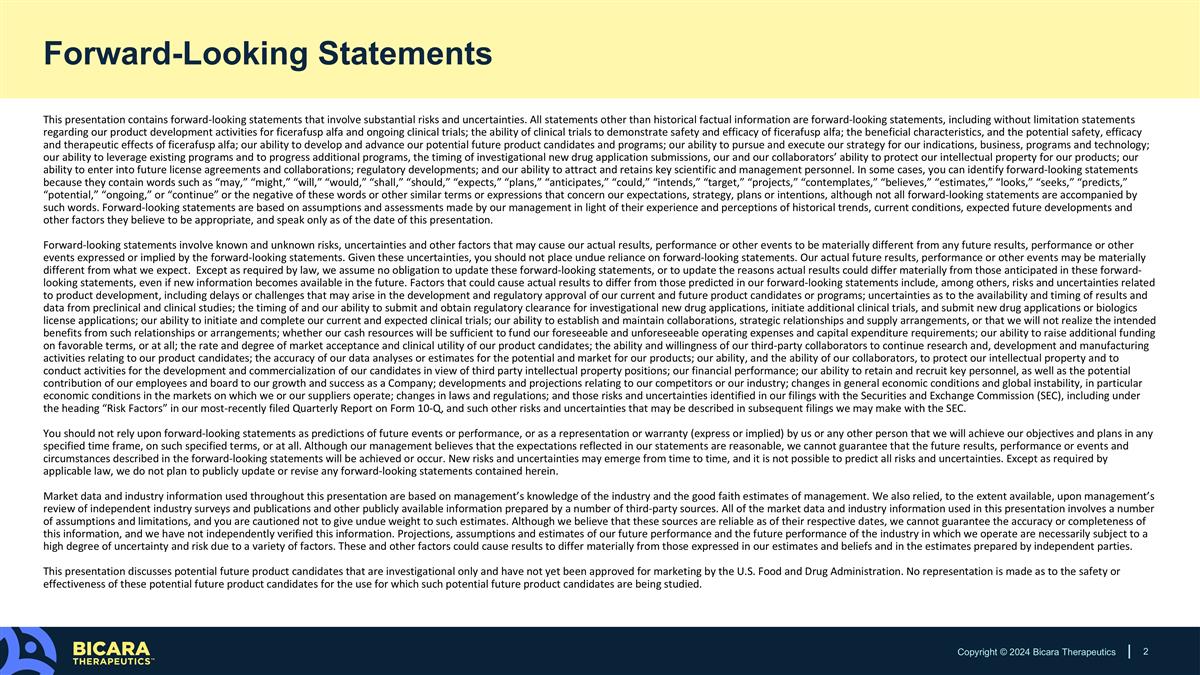
Forward-Looking Statements This presentation contains forward-looking statements that involve substantial risks and uncertainties. All statements other than historical factual information are forward-looking statements, including without limitation statements regarding our product development activities for ficerafusp alfa and ongoing clinical trials; the ability of clinical trials to demonstrate safety and efficacy of ficerafusp alfa; the beneficial characteristics, and the potential safety, efficacy and therapeutic effects of ficerafusp alfa; our ability to develop and advance our potential future product candidates and programs; our ability to pursue and execute our strategy for our indications, business, programs and technology; our ability to leverage existing programs and to progress additional programs, the timing of investigational new drug application submissions, our and our collaborators’ ability to protect our intellectual property for our products; our ability to enter into future license agreements and collaborations; regulatory developments; and our ability to attract and retains key scientific and management personnel. In some cases, you can identify forward-looking statements because they contain words such as “may,” “might,” “will,” “would,” “shall,” “should,” “expects,” “plans,” “anticipates,” “could,” “intends,” “target,” “projects,” “contemplates,” “believes,” “estimates,” “looks,” “seeks,” “predicts,” “potential,” “ongoing,” or “continue” or the negative of these words or other similar terms or expressions that concern our expectations, strategy, plans or intentions, although not all forward-looking statements are accompanied by such words. Forward-looking statements are based on assumptions and assessments made by our management in light of their experience and perceptions of historical trends, current conditions, expected future developments and other factors they believe to be appropriate, and speak only as of the date of this presentation. Forward-looking statements involve known and unknown risks, uncertainties and other factors that may cause our actual results, performance or other events to be materially different from any future results, performance or other events expressed or implied by the forward-looking statements. Given these uncertainties, you should not place undue reliance on forward-looking statements. Our actual future results, performance or other events may be materially different from what we expect. Except as required by law, we assume no obligation to update these forward-looking statements, or to update the reasons actual results could differ materially from those anticipated in these forward-looking statements, even if new information becomes available in the future. Factors that could cause actual results to differ from those predicted in our forward-looking statements include, among others, risks and uncertainties related to product development, including delays or challenges that may arise in the development and regulatory approval of our current and future product candidates or programs; uncertainties as to the availability and timing of results and data from preclinical and clinical studies; the timing of and our ability to submit and obtain regulatory clearance for investigational new drug applications, initiate additional clinical trials, and submit new drug applications or biologics license applications; our ability to initiate and complete our current and expected clinical trials; our ability to establish and maintain collaborations, strategic relationships and supply arrangements, or that we will not realize the intended benefits from such relationships or arrangements; whether our cash resources will be sufficient to fund our foreseeable and unforeseeable operating expenses and capital expenditure requirements; our ability to raise additional funding on favorable terms, or at all; the rate and degree of market acceptance and clinical utility of our product candidates; the ability and willingness of our third-party collaborators to continue research and, development and manufacturing activities relating to our product candidates; the accuracy of our data analyses or estimates for the potential and market for our products; our ability, and the ability of our collaborators, to protect our intellectual property and to conduct activities for the development and commercialization of our candidates in view of third party intellectual property positions; our financial performance; our ability to retain and recruit key personnel, as well as the potential contribution of our employees and board to our growth and success as a Company; developments and projections relating to our competitors or our industry; changes in general economic conditions and global instability, in particular economic conditions in the markets on which we or our suppliers operate; changes in laws and regulations; and those risks and uncertainties identified in our filings with the Securities and Exchange Commission (SEC), including under the heading “Risk Factors” in our most-recently filed Quarterly Report on Form 10-Q, and such other risks and uncertainties that may be described in subsequent filings we may make with the SEC. You should not rely upon forward-looking statements as predictions of future events or performance, or as a representation or warranty (express or implied) by us or any other person that we will achieve our objectives and plans in any specified time frame, on such specified terms, or at all. Although our management believes that the expectations reflected in our statements are reasonable, we cannot guarantee that the future results, performance or events and circumstances described in the forward-looking statements will be achieved or occur. New risks and uncertainties may emerge from time to time, and it is not possible to predict all risks and uncertainties. Except as required by applicable law, we do not plan to publicly update or revise any forward-looking statements contained herein. Market data and industry information used throughout this presentation are based on management’s knowledge of the industry and the good faith estimates of management. We also relied, to the extent available, upon management’s review of independent industry surveys and publications and other publicly available information prepared by a number of third-party sources. All of the market data and industry information used in this presentation involves a number of assumptions and limitations, and you are cautioned not to give undue weight to such estimates. Although we believe that these sources are reliable as of their respective dates, we cannot guarantee the accuracy or completeness of this information, and we have not independently verified this information. Projections, assumptions and estimates of our future performance and the future performance of the industry in which we operate are necessarily subject to a high degree of uncertainty and risk due to a variety of factors. These and other factors could cause results to differ materially from those expressed in our estimates and beliefs and in the estimates prepared by independent parties. This presentation discusses potential future product candidates that are investigational only and have not yet been approved for marketing by the U.S. Food and Drug Administration. No representation is made as to the safety or effectiveness of these potential future product candidates for the use for which such potential future product candidates are being studied. Copyright © 2024 Bicara Therapeutics
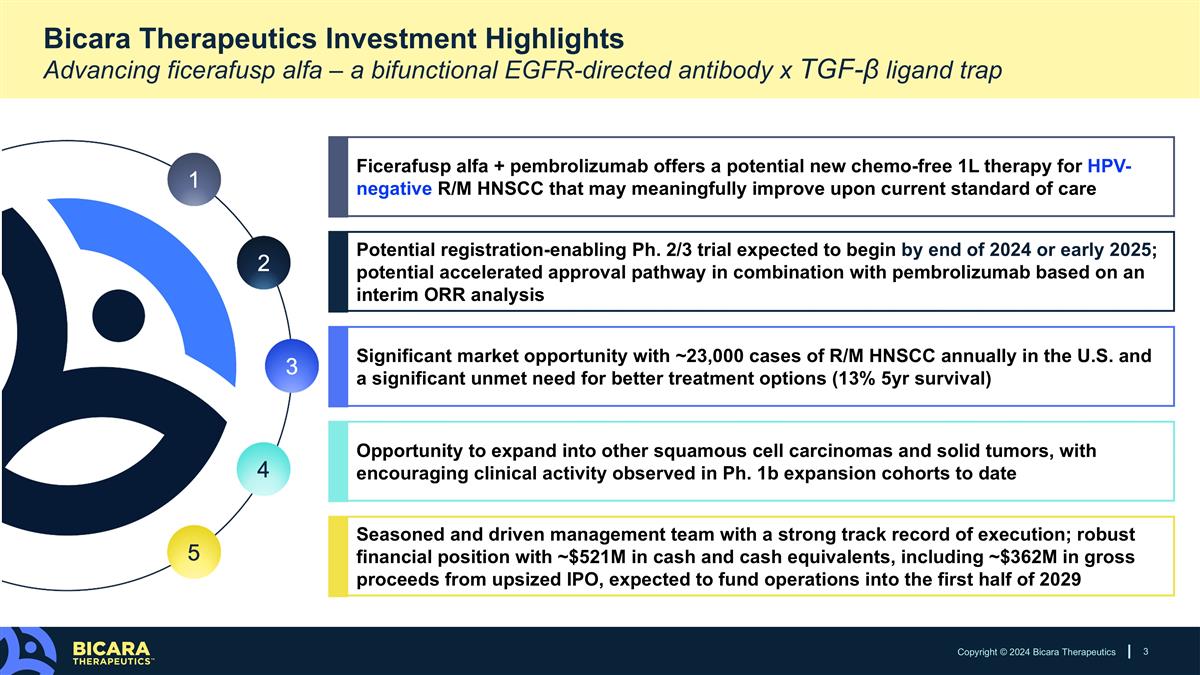
Copyright © 2024 Bicara Therapeutics Bicara Therapeutics Investment Highlights Advancing ficerafusp alfa – a bifunctional EGFR-directed antibody x TGF-β ligand trap 1 5 4 3 2 Ficerafusp alfa + pembrolizumab offers a potential new chemo-free 1L therapy for HPV-negative R/M HNSCC that may meaningfully improve upon current standard of care Potential registration-enabling Ph. 2/3 trial expected to begin by end of 2024 or early 2025; potential accelerated approval pathway in combination with pembrolizumab based on an interim ORR analysis Significant market opportunity with ~23,000 cases of R/M HNSCC annually in the U.S. and a significant unmet need for better treatment options (13% 5yr survival) Opportunity to expand into other squamous cell carcinomas and solid tumors, with encouraging clinical activity observed in Ph. 1b expansion cohorts to date Seasoned and driven management team with a strong track record of execution; robust financial position with ~$521M in cash and cash equivalents, including ~$362M in gross proceeds from upsized IPO, expected to fund operations into the first half of 2029
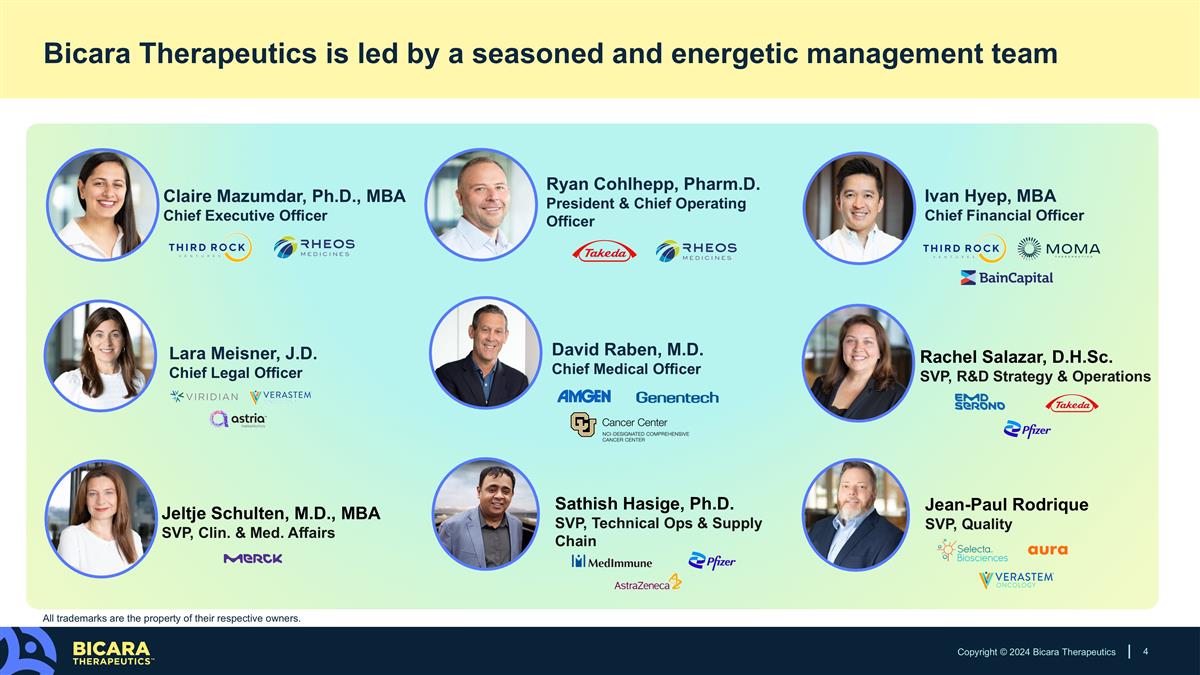
Bicara Therapeutics is led by a seasoned and energetic management team Copyright © 2024 Bicara Therapeutics Claire Mazumdar, Ph.D., MBA Chief Executive Officer Ivan Hyep, MBA Chief Financial Officer Ryan Cohlhepp, Pharm.D. President & Chief Operating Officer David Raben, M.D. Chief Medical Officer Jeltje Schulten, M.D., MBA SVP, Clin. & Med. Affairs Sathish Hasige, Ph.D. SVP, Technical Ops & Supply Chain Lara Meisner, J.D. Chief Legal Officer Rachel Salazar, D.H.Sc. SVP, R&D Strategy & Operations All trademarks are the property of their respective owners. Jean-Paul Rodrique SVP, Quality
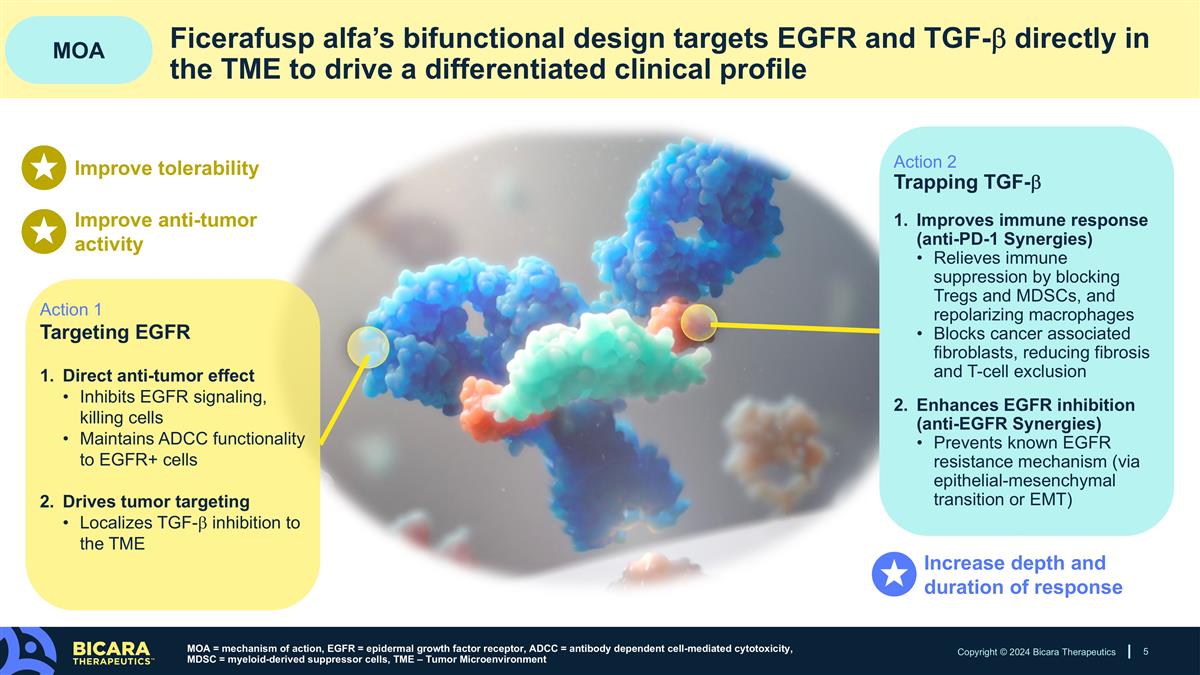
Copyright © 2024 Bicara Therapeutics Ficerafusp alfa’s bifunctional design targets EGFR and TGF-b directly in the TME to drive a differentiated clinical profile MOA Action 1 Targeting EGFR Direct anti-tumor effect Inhibits EGFR signaling, killing cells Maintains ADCC functionality to EGFR+ cells Drives tumor targeting Localizes TGF-b inhibition to the TME Action 2 Trapping TGF-b Improves immune response (anti-PD-1 Synergies) Relieves immune suppression by blocking Tregs and MDSCs, and repolarizing macrophages Blocks cancer associated fibroblasts, reducing fibrosis and T-cell exclusion Enhances EGFR inhibition (anti-EGFR Synergies) Prevents known EGFR resistance mechanism (via epithelial-mesenchymal transition or EMT) Improve tolerability Improve anti-tumor activity Increase depth and duration of response MOA = mechanism of action, EGFR = epidermal growth factor receptor, ADCC = antibody dependent cell-mediated cytotoxicity, MDSC = myeloid-derived suppressor cells, TME – Tumor Microenvironment
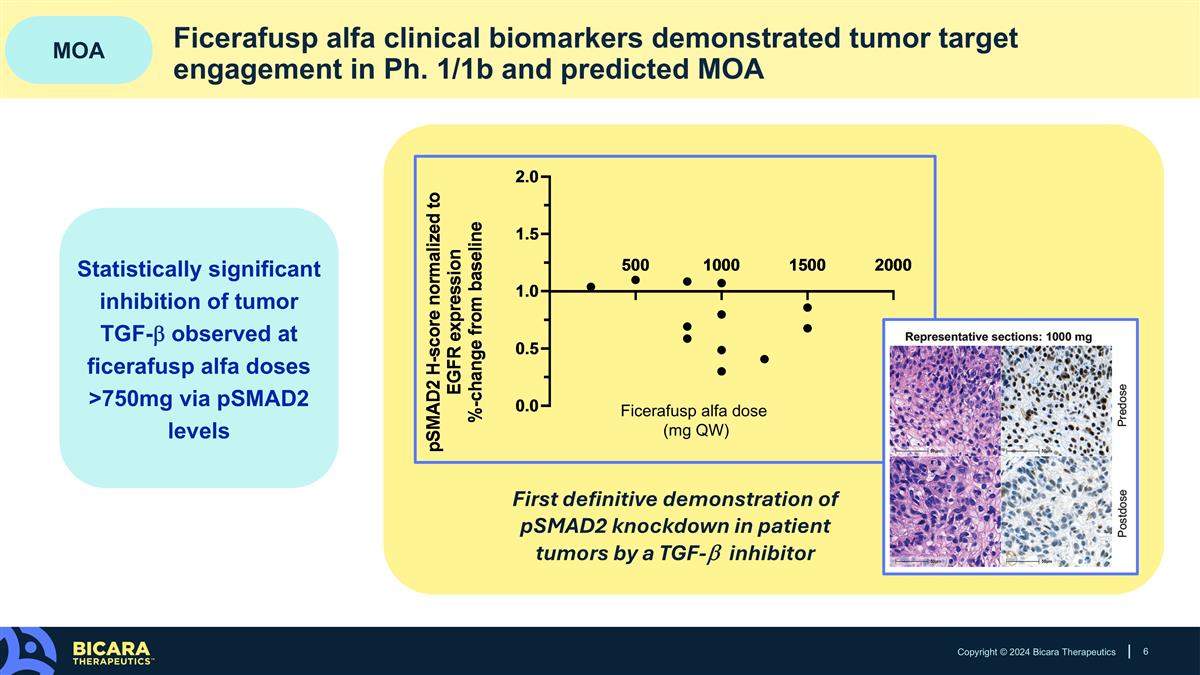
Ficerafusp alfa clinical biomarkers demonstrated tumor target engagement in Ph. 1/1b and predicted MOA Copyright © 2024 Bicara Therapeutics MOA First definitive demonstration of pSMAD2 knockdown in patient tumors by a TGF-b inhibitor Ficerafusp alfa dose (mg QW) Statistically significant inhibition of tumor TGF-b observed at ficerafusp alfa doses >750mg via pSMAD2 levels
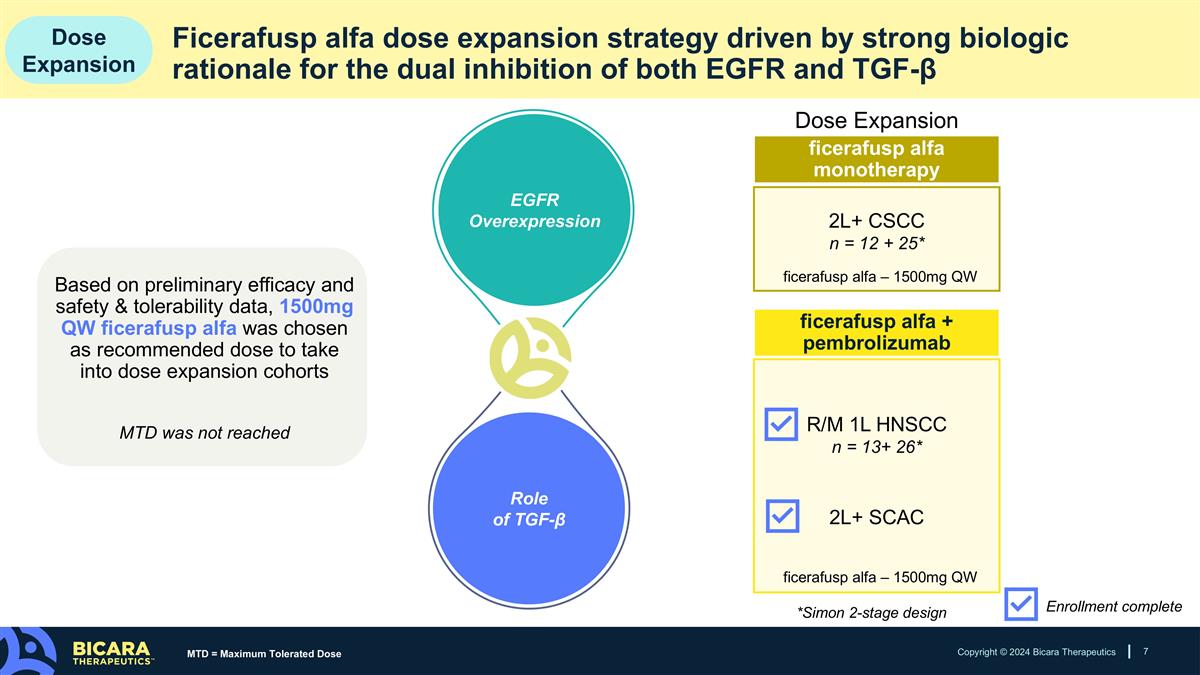
EGFR Overexpression Role of TGF-β Copyright © 2024 Bicara Therapeutics Ficerafusp alfa dose expansion strategy driven by strong biologic rationale for the dual inhibition of both EGFR and TGF-β 2L+ CSCC n = 12 + 25* ficerafusp alfa monotherapy R/M 1L HNSCC n = 13+ 26* 2L+ SCAC ficerafusp alfa + pembrolizumab Dose Expansion *Simon 2-stage design ficerafusp alfa – 1500mg QW ficerafusp alfa – 1500mg QW Dose Expansion Enrollment complete Based on preliminary efficacy and safety & tolerability data, 1500mg QW ficerafusp alfa was chosen as recommended dose to take into dose expansion cohorts MTD was not reached MTD = Maximum Tolerated Dose
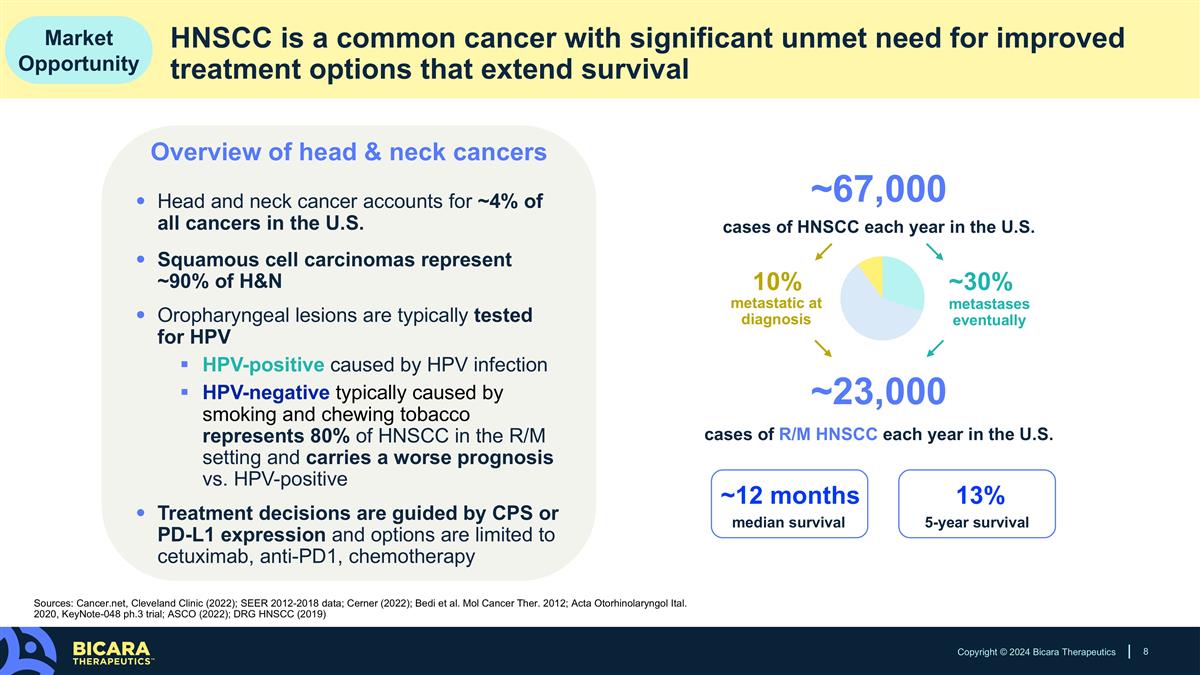
Copyright © 2024 Bicara Therapeutics Sources: Cancer.net, Cleveland Clinic (2022); SEER 2012-2018 data; Cerner (2022); Bedi et al. Mol Cancer Ther. 2012; Acta Otorhinolaryngol Ital. 2020, KeyNote-048 ph.3 trial; ASCO (2022); DRG HNSCC (2019) HNSCC is a common cancer with significant unmet need for improved treatment options that extend survival ~67,000 cases of HNSCC each year in the U.S. 10% ~30% ~23,000 cases of R/M HNSCC each year in the U.S. ~12 months 13% Overview of head & neck cancers Head and neck cancer accounts for ~4% of all cancers in the U.S. Squamous cell carcinomas represent ~90% of H&N Oropharyngeal lesions are typically tested for HPV HPV-positive caused by HPV infection HPV-negative typically caused by smoking and chewing tobacco represents 80% of HNSCC in the R/M setting and carries a worse prognosis vs. HPV-positive Treatment decisions are guided by CPS or PD-L1 expression and options are limited to cetuximab, anti-PD1, chemotherapy metastatic at diagnosis metastases eventually median survival 5-year survival Market Opportunity
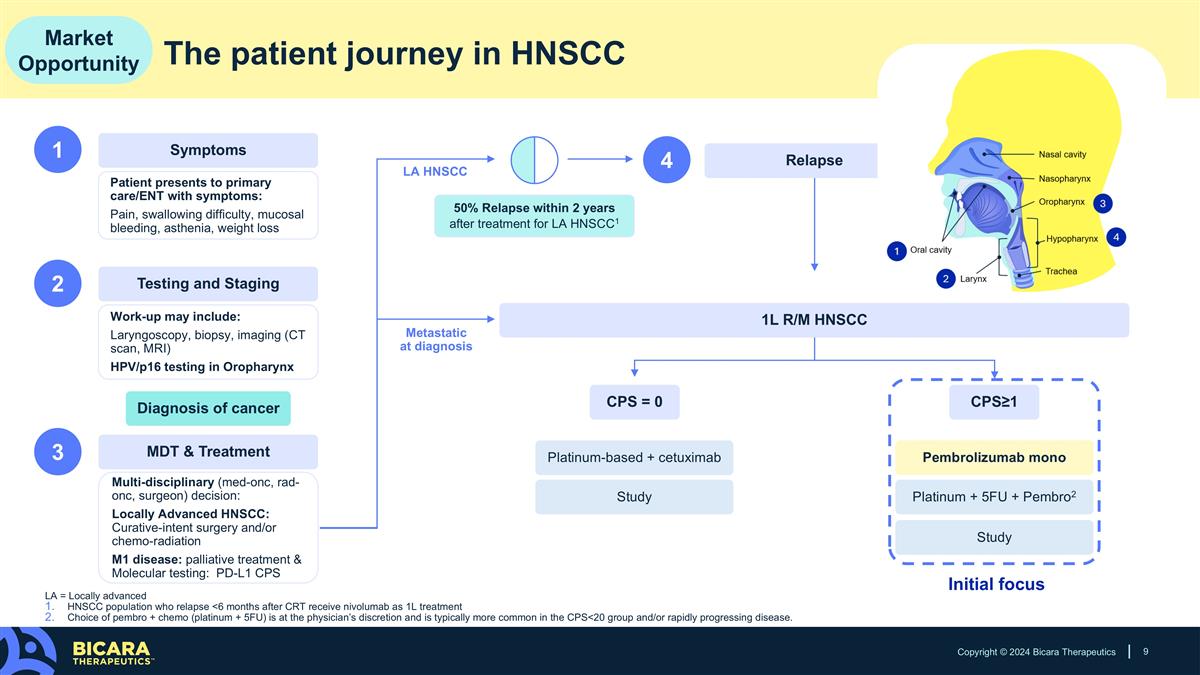
Copyright © 2024 Bicara Therapeutics Symptoms Testing and Staging MDT & Treatment Patient presents to primary care/ENT with symptoms: Pain, swallowing difficulty, mucosal bleeding, asthenia, weight loss 1 2 3 Diagnosis of cancer Work-up may include: Laryngoscopy, biopsy, imaging (CT scan, MRI) HPV/p16 testing in Oropharynx Multi-disciplinary (med-onc, rad-onc, surgeon) decision: Locally Advanced HNSCC: Curative-intent surgery and/or chemo-radiation M1 disease: palliative treatment & Molecular testing: PD-L1 CPS 4 Relapse 1L R/M HNSCC CPS = 0 CPS≥1 Platinum-based + cetuximab Study Platinum + 5FU + Pembro2 Study Pembrolizumab mono 50% Relapse within 2 years after treatment for LA HNSCC1 LA = Locally advanced HNSCC population who relapse <6 months after CRT receive nivolumab as 1L treatment Choice of pembro + chemo (platinum + 5FU) is at the physician’s discretion and is typically more common in the CPS<20 group and/or rapidly progressing disease. LA HNSCC Metastatic at diagnosis Initial focus The patient journey in HNSCC Market Opportunity
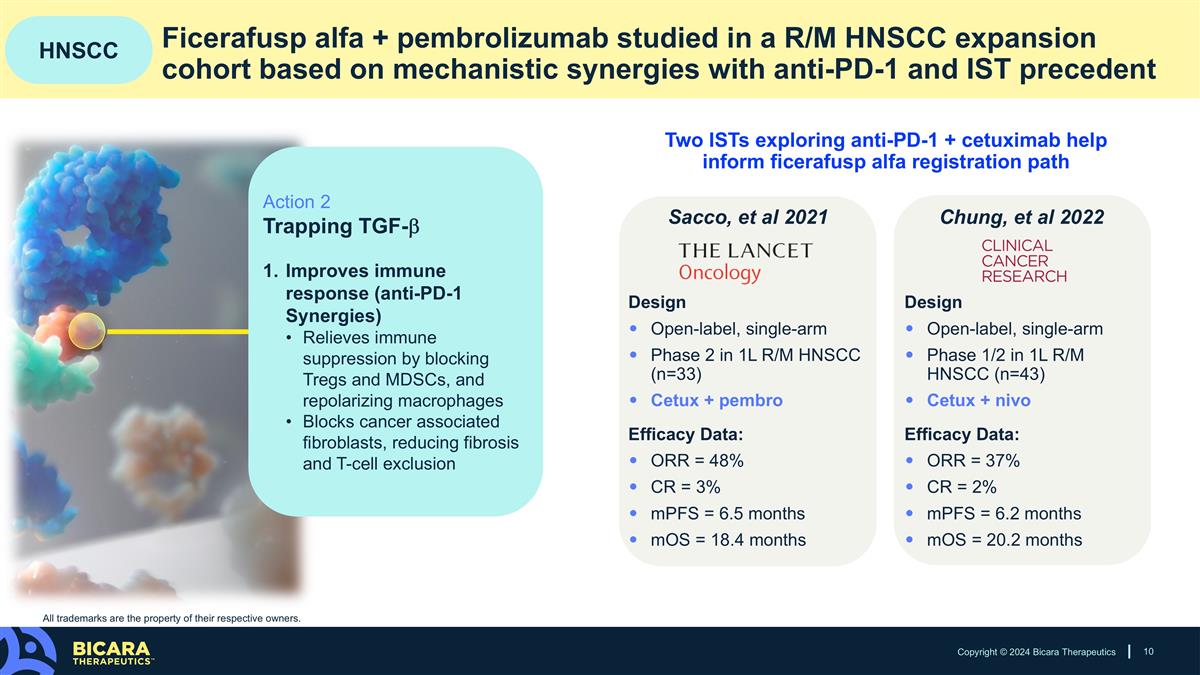
Copyright © 2024 Bicara Therapeutics Ficerafusp alfa + pembrolizumab studied in a R/M HNSCC expansion cohort based on mechanistic synergies with anti-PD-1 and IST precedent Design Open-label, single-arm Phase 2 in 1L R/M HNSCC (n=33) Cetux + pembro Efficacy Data: ORR = 48% CR = 3% mPFS = 6.5 months mOS = 18.4 months Design Open-label, single-arm Phase 1/2 in 1L R/M HNSCC (n=43) Cetux + nivo Efficacy Data: ORR = 37% CR = 2% mPFS = 6.2 months mOS = 20.2 months Two ISTs exploring anti-PD-1 + cetuximab help inform ficerafusp alfa registration path Sacco, et al 2021 Chung, et al 2022 HNSCC Action 2 Trapping TGF-b Improves immune response (anti-PD-1 Synergies) Relieves immune suppression by blocking Tregs and MDSCs, and repolarizing macrophages Blocks cancer associated fibroblasts, reducing fibrosis and T-cell exclusion All trademarks are the property of their respective owners.
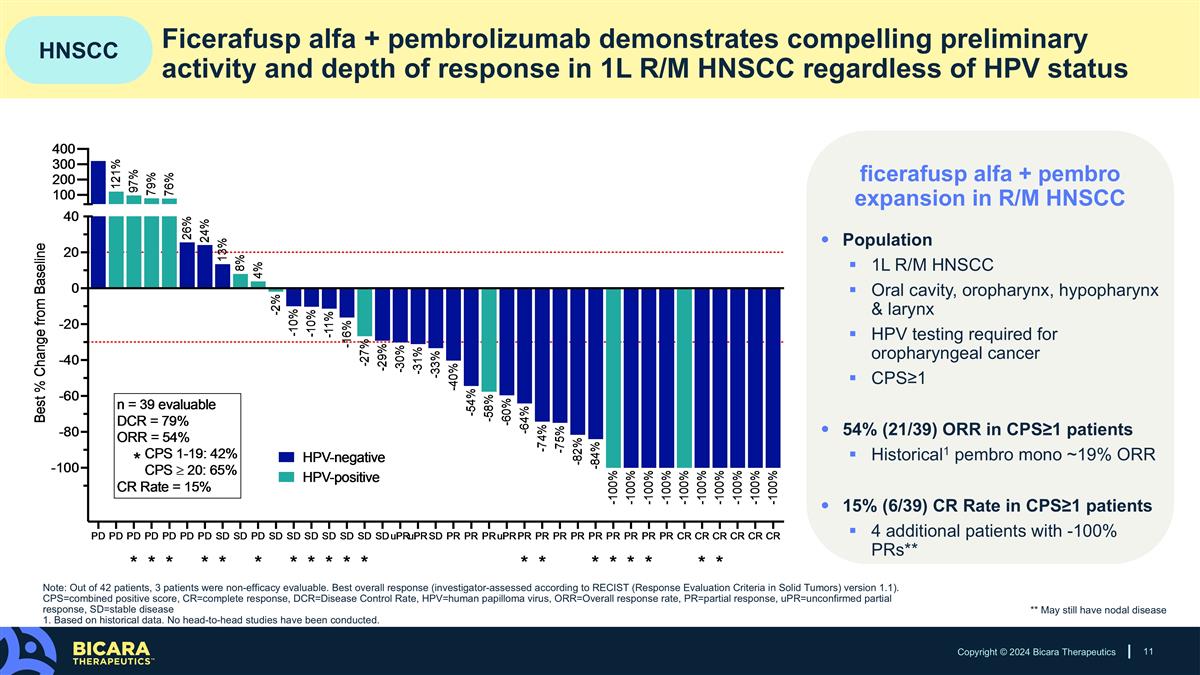
Copyright © 2024 Bicara Therapeutics Ficerafusp alfa + pembrolizumab demonstrates compelling preliminary activity and depth of response in 1L R/M HNSCC regardless of HPV status Note: Out of 42 patients, 3 patients were non-efficacy evaluable. Best overall response (investigator-assessed according to RECIST (Response Evaluation Criteria in Solid Tumors) version 1.1). CPS=combined positive score, CR=complete response, DCR=Disease Control Rate, HPV=human papilloma virus, ORR=Overall response rate, PR=partial response, uPR=unconfirmed partial response, SD=stable disease 1. Based on historical data. No head-to-head studies have been conducted. ficerafusp alfa + pembro expansion in R/M HNSCC Population 1L R/M HNSCC Oral cavity, oropharynx, hypopharynx & larynx HPV testing required for oropharyngeal cancer CPS≥1 54% (21/39) ORR in CPS≥1 patients Historical1 pembro mono ~19% ORR 15% (6/39) CR Rate in CPS≥1 patients 4 additional patients with -100% PRs** ** May still have nodal disease HNSCC
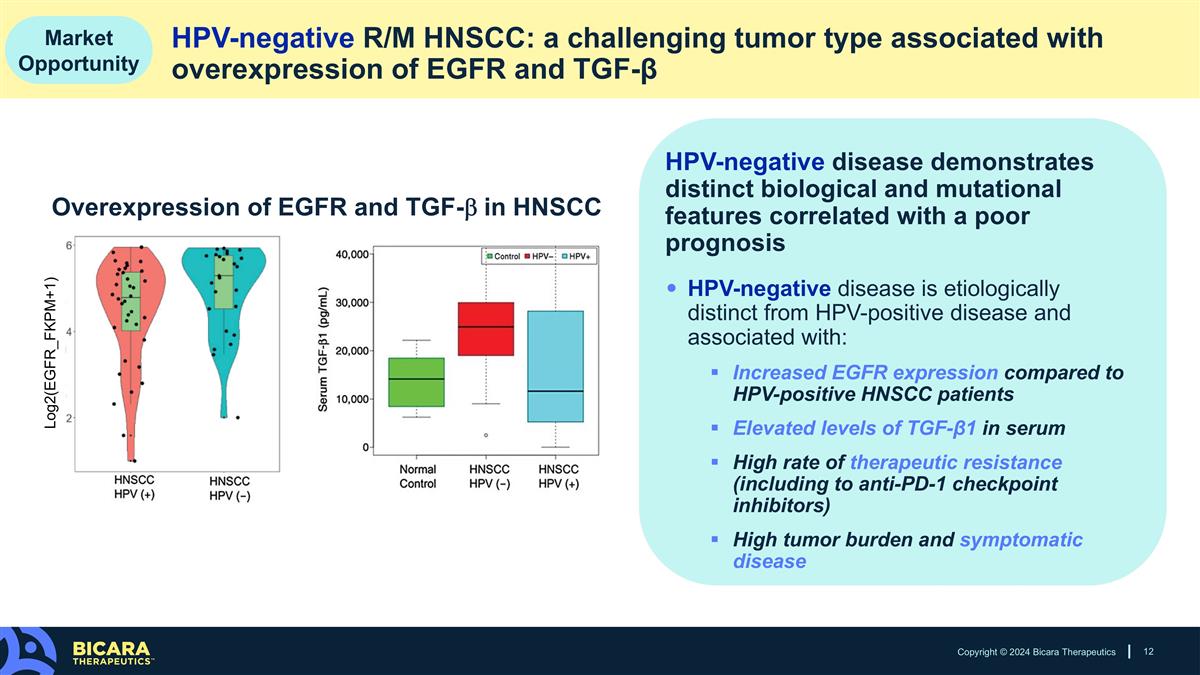
HPV-negative disease demonstrates distinct biological and mutational features correlated with a poor prognosis HPV-negative disease is etiologically distinct from HPV-positive disease and associated with: Increased EGFR expression compared to HPV-positive HNSCC patients Elevated levels of TGF-β1 in serum High rate of therapeutic resistance (including to anti-PD-1 checkpoint inhibitors) High tumor burden and symptomatic disease Copyright © 2024 Bicara Therapeutics HPV-negative R/M HNSCC: a challenging tumor type associated with overexpression of EGFR and TGF-β Overexpression of EGFR and TGF-b in HNSCC Log2(EGFR_FKPM+1) Market Opportunity
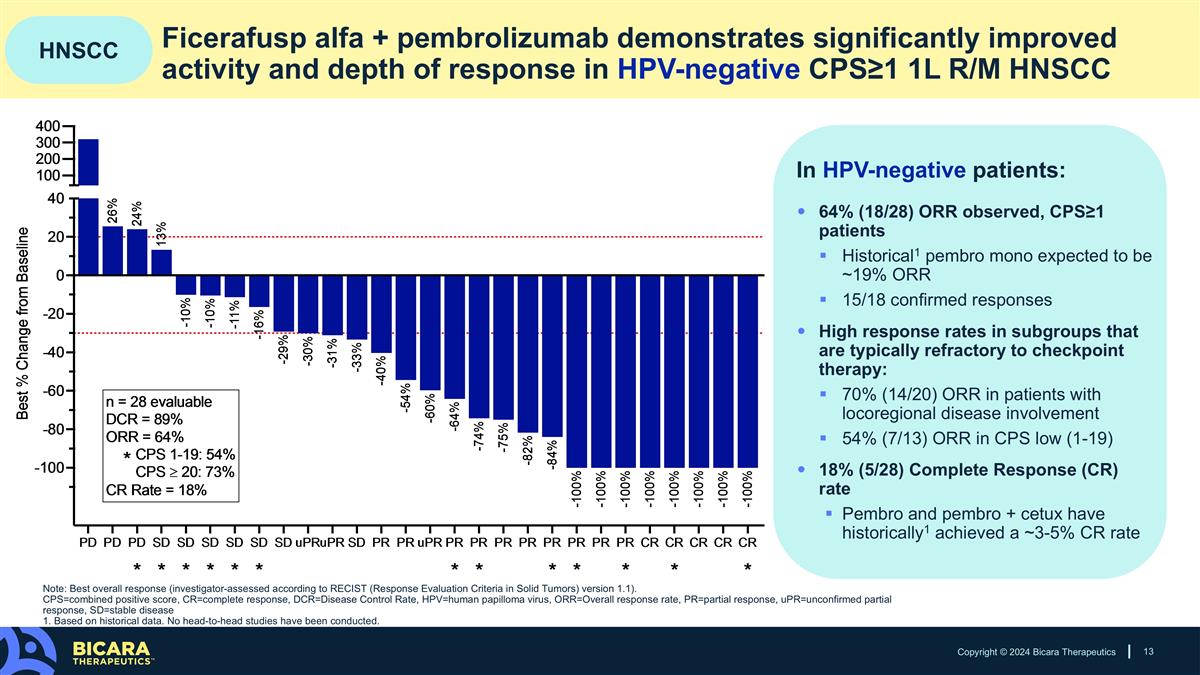
Copyright © 2024 Bicara Therapeutics Ficerafusp alfa + pembrolizumab demonstrates significantly improved activity and depth of response in HPV-negative CPS≥1 1L R/M HNSCC In HPV-negative patients: 64% (18/28) ORR observed, CPS≥1 patients Historical1 pembro mono expected to be ~19% ORR 15/18 confirmed responses High response rates in subgroups that are typically refractory to checkpoint therapy: 70% (14/20) ORR in patients with locoregional disease involvement 54% (7/13) ORR in CPS low (1-19) 18% (5/28) Complete Response (CR) rate Pembro and pembro + cetux have historically1 achieved a ~3-5% CR rate HNSCC Note: Best overall response (investigator-assessed according to RECIST (Response Evaluation Criteria in Solid Tumors) version 1.1). CPS=combined positive score, CR=complete response, DCR=Disease Control Rate, HPV=human papilloma virus, ORR=Overall response rate, PR=partial response, uPR=unconfirmed partial response, SD=stable disease 1. Based on historical data. No head-to-head studies have been conducted.
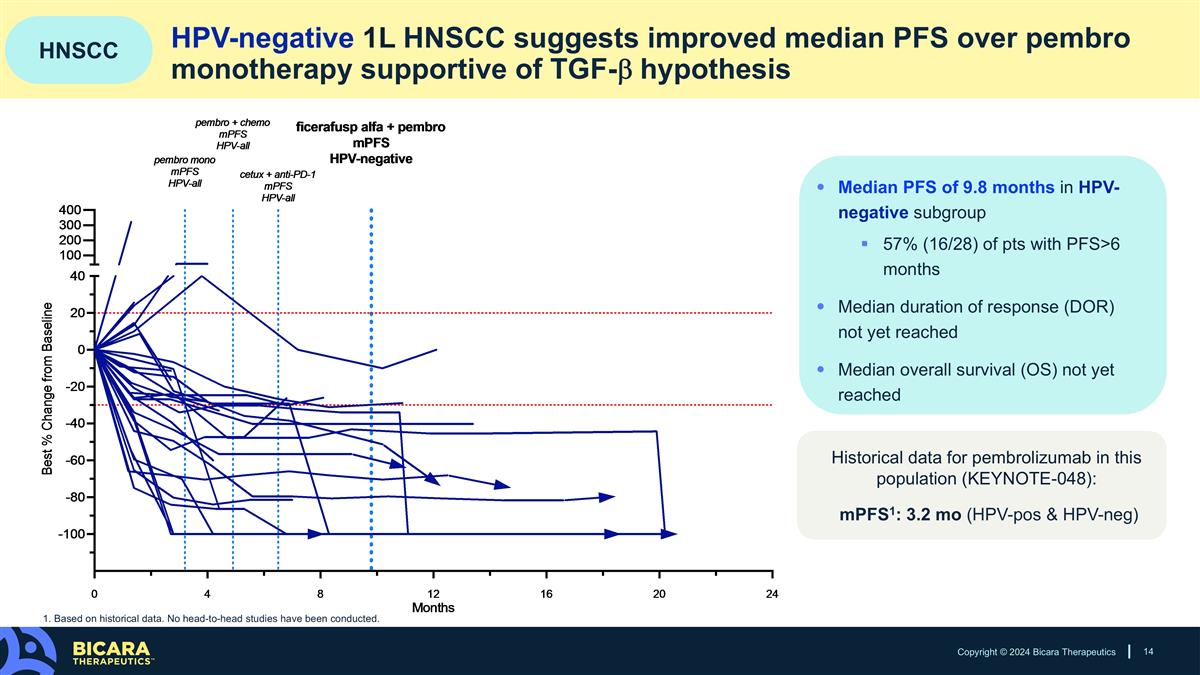
Copyright © 2024 Bicara Therapeutics HPV-negative 1L HNSCC suggests improved median PFS over pembro monotherapy supportive of TGF-b hypothesis Median PFS of 9.8 months in HPV-negative subgroup 57% (16/28) of pts with PFS>6 months Median duration of response (DOR) not yet reached Median overall survival (OS) not yet reached Historical data for pembrolizumab in this population (KEYNOTE-048): mPFS1: 3.2 mo (HPV-pos & HPV-neg) HNSCC 1. Based on historical data. No head-to-head studies have been conducted.
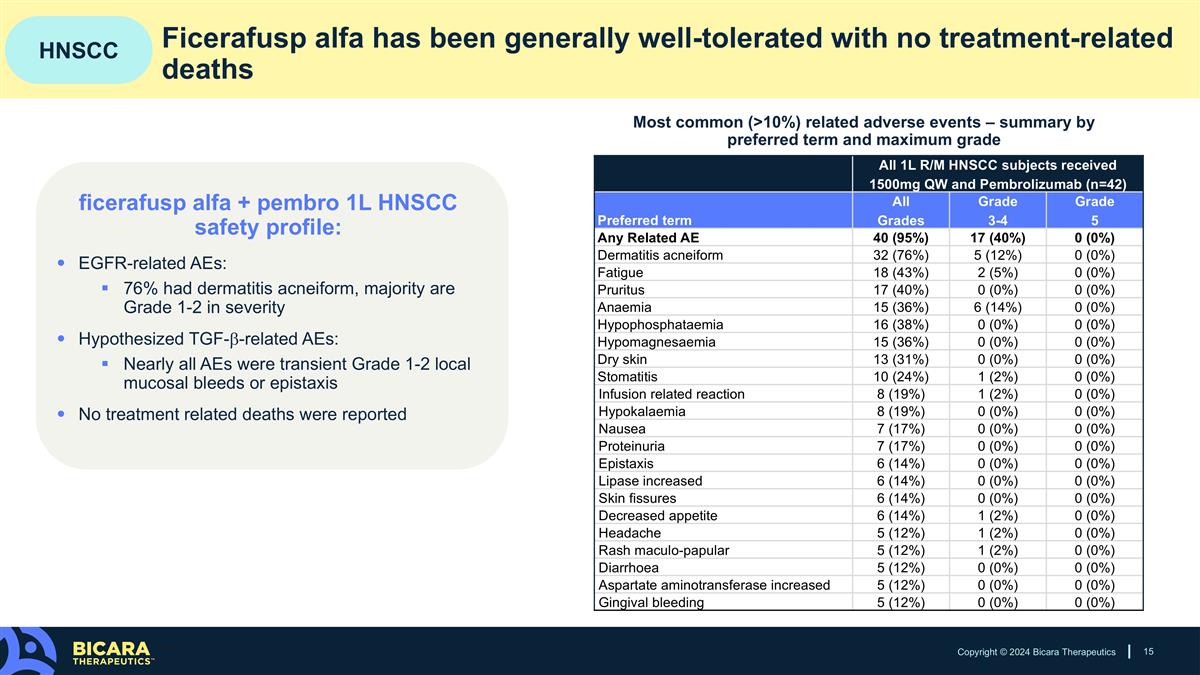
Copyright © 2024 Bicara Therapeutics Ficerafusp alfa has been generally well-tolerated with no treatment-related deaths HNSCC Most common (>10%) related adverse events – summary by preferred term and maximum grade ficerafusp alfa + pembro 1L HNSCC safety profile: EGFR-related AEs: 76% had dermatitis acneiform, majority are Grade 1-2 in severity Hypothesized TGF-b-related AEs: Nearly all AEs were transient Grade 1-2 local mucosal bleeds or epistaxis No treatment related deaths were reported All 1L R/M HNSCC subjects received 1500mg QW and Pembrolizumab (n=42) Preferred term All Grades Grade 3-4 Grade 5 Any Related AE 40 (95%) 17 (40%) 0 (0%) Dermatitis acneiform 32 (76%) 5 (12%) 0 (0%) Fatigue 18 (43%) 2 (5%) 0 (0%) Pruritus 17 (40%) 0 (0%) 0 (0%) Anaemia 15 (36%) 6 (14%) 0 (0%) Hypophosphataemia 16 (38%) 0 (0%) 0 (0%) Hypomagnesaemia 15 (36%) 0 (0%) 0 (0%) Dry skin 13 (31%) 0 (0%) 0 (0%) Stomatitis 10 (24%) 1 (2%) 0 (0%) Infusion related reaction 8 (19%) 1 (2%) 0 (0%) Hypokalaemia 8 (19%) 0 (0%) 0 (0%) Nausea 7 (17%) 0 (0%) 0 (0%) Proteinuria 7 (17%) 0 (0%) 0 (0%) Epistaxis 6 (14%) 0 (0%) 0 (0%) Lipase increased 6 (14%) 0 (0%) 0 (0%) Skin fissures 6 (14%) 0 (0%) 0 (0%) Decreased appetite 6 (14%) 1 (2%) 0 (0%) Headache 5 (12%) 1 (2%) 0 (0%) Rash maculo-papular 5 (12%) 1 (2%) 0 (0%) Diarrhoea 5 (12%) 0 (0%) 0 (0%) Aspartate aminotransferase increased 5 (12%) 0 (0%) 0 (0%) Gingival bleeding 5 (12%) 0 (0%) 0 (0%)
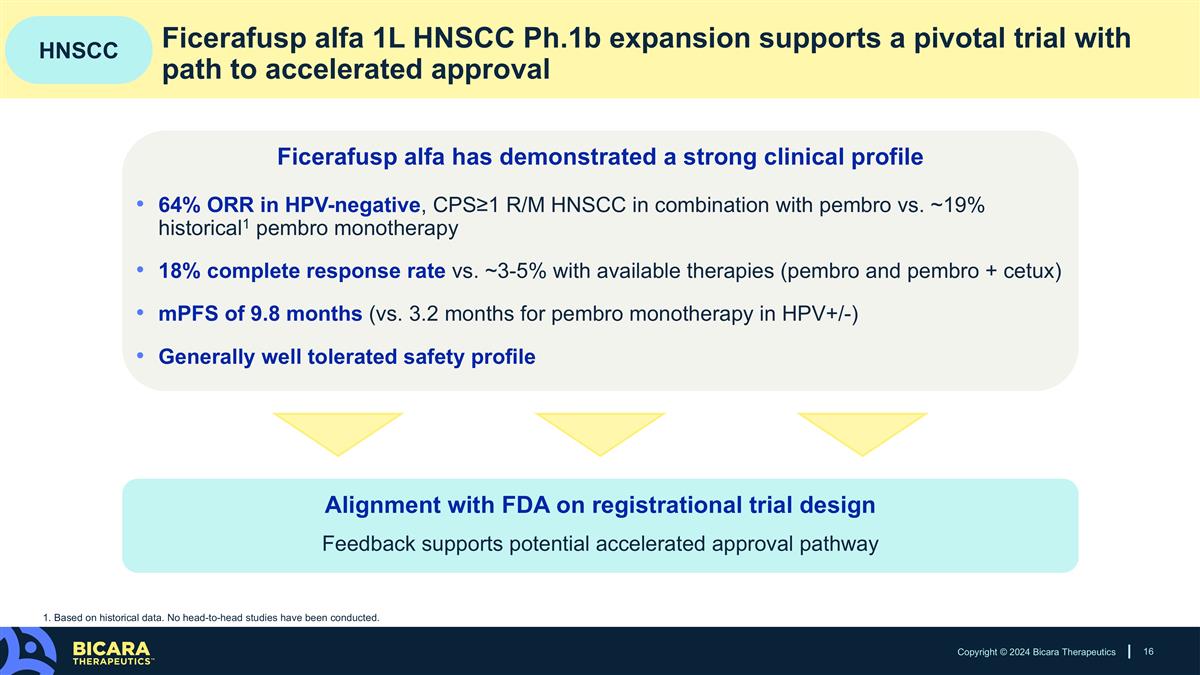
Copyright © 2024 Bicara Therapeutics Ficerafusp alfa 1L HNSCC Ph.1b expansion supports a pivotal trial with path to accelerated approval Alignment with FDA on registrational trial design Feedback supports potential accelerated approval pathway 64% ORR in HPV-negative, CPS≥1 R/M HNSCC in combination with pembro vs. ~19% historical1 pembro monotherapy 18% complete response rate vs. ~3-5% with available therapies (pembro and pembro + cetux) mPFS of 9.8 months (vs. 3.2 months for pembro monotherapy in HPV+/-) Generally well tolerated safety profile Ficerafusp alfa has demonstrated a strong clinical profile HNSCC 1. Based on historical data. No head-to-head studies have been conducted.
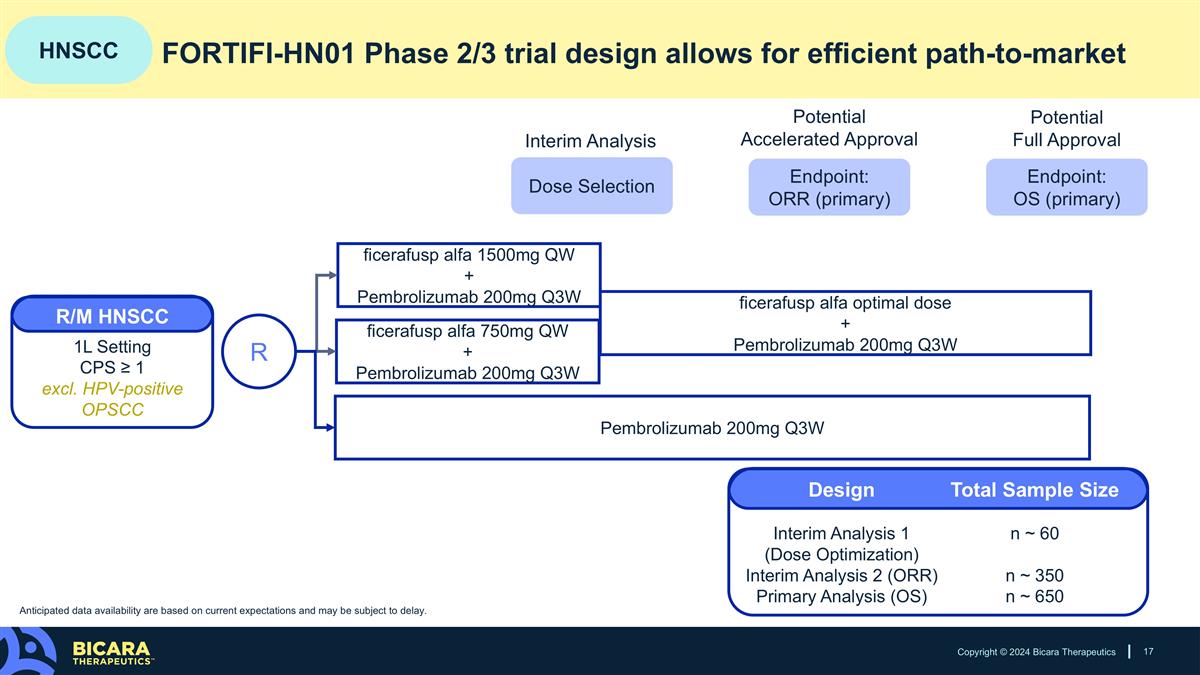
Copyright © 2024 Bicara Therapeutics FORTIFI-HN01 Phase 2/3 trial design allows for efficient path-to-market R/M HNSCC 1L Setting CPS ≥ 1 excl. HPV-positive OPSCC R ficerafusp alfa 1500mg QW + Pembrolizumab 200mg Q3W ficerafusp alfa 750mg QW + Pembrolizumab 200mg Q3W Pembrolizumab 200mg Q3W ficerafusp alfa optimal dose + Pembrolizumab 200mg Q3W Dose Selection Endpoint: ORR (primary) Endpoint: OS (primary) Interim Analysis Potential Accelerated Approval Potential Full Approval Design Interim Analysis 1 (Dose Optimization) Interim Analysis 2 (ORR) Primary Analysis (OS) Total Sample Size n ~ 60 n ~ 350 n ~ 650 HNSCC Anticipated data availability are based on current expectations and may be subject to delay.
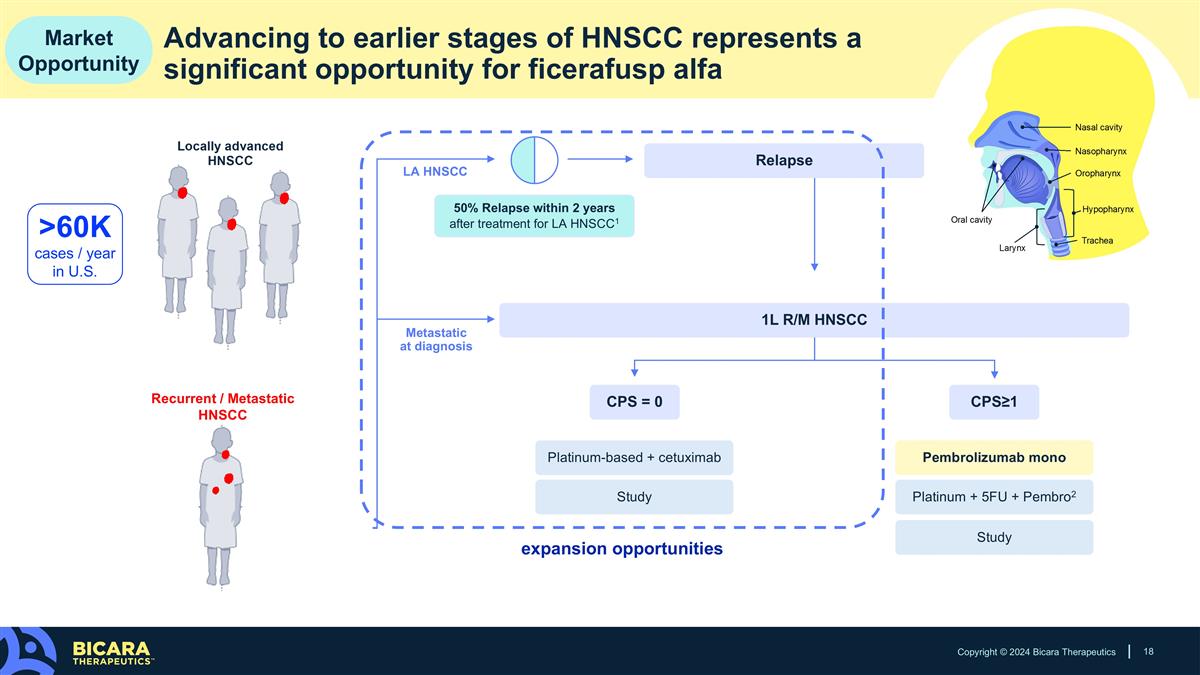
Copyright © 2024 Bicara Therapeutics Relapse 1L R/M HNSCC CPS = 0 CPS≥1 Platinum-based + cetuximab Study Platinum + 5FU + Pembro2 Study Pembrolizumab mono 50% Relapse within 2 years after treatment for LA HNSCC1 LA HNSCC Metastatic at diagnosis expansion opportunities Advancing to earlier stages of HNSCC represents a significant opportunity for ficerafusp alfa Market Opportunity >60K cases / year in U.S. Recurrent / Metastatic HNSCC
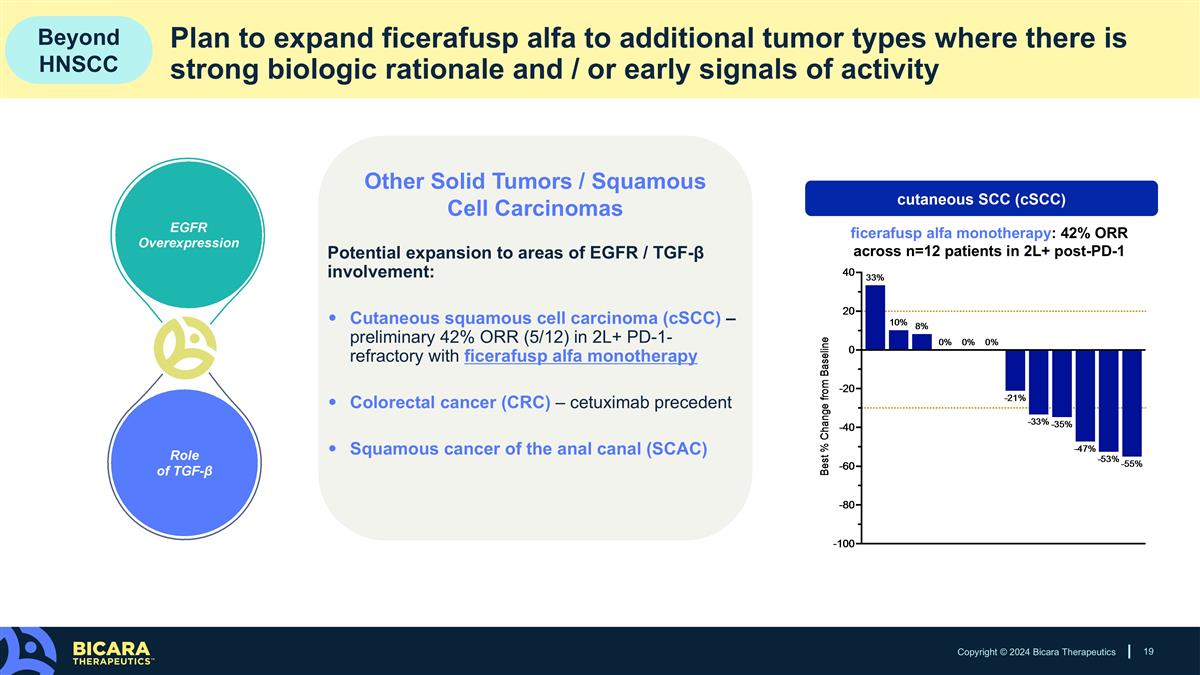
Potential expansion to areas of EGFR / TGF-β involvement: Cutaneous squamous cell carcinoma (cSCC) – preliminary 42% ORR (5/12) in 2L+ PD-1-refractory with ficerafusp alfa monotherapy Colorectal cancer (CRC) – cetuximab precedent Squamous cancer of the anal canal (SCAC) Copyright © 2024 Bicara Therapeutics Plan to expand ficerafusp alfa to additional tumor types where there is strong biologic rationale and / or early signals of activity Other Solid Tumors / Squamous Cell Carcinomas Beyond HNSCC ficerafusp alfa monotherapy: 42% ORR across n=12 patients in 2L+ post-PD-1
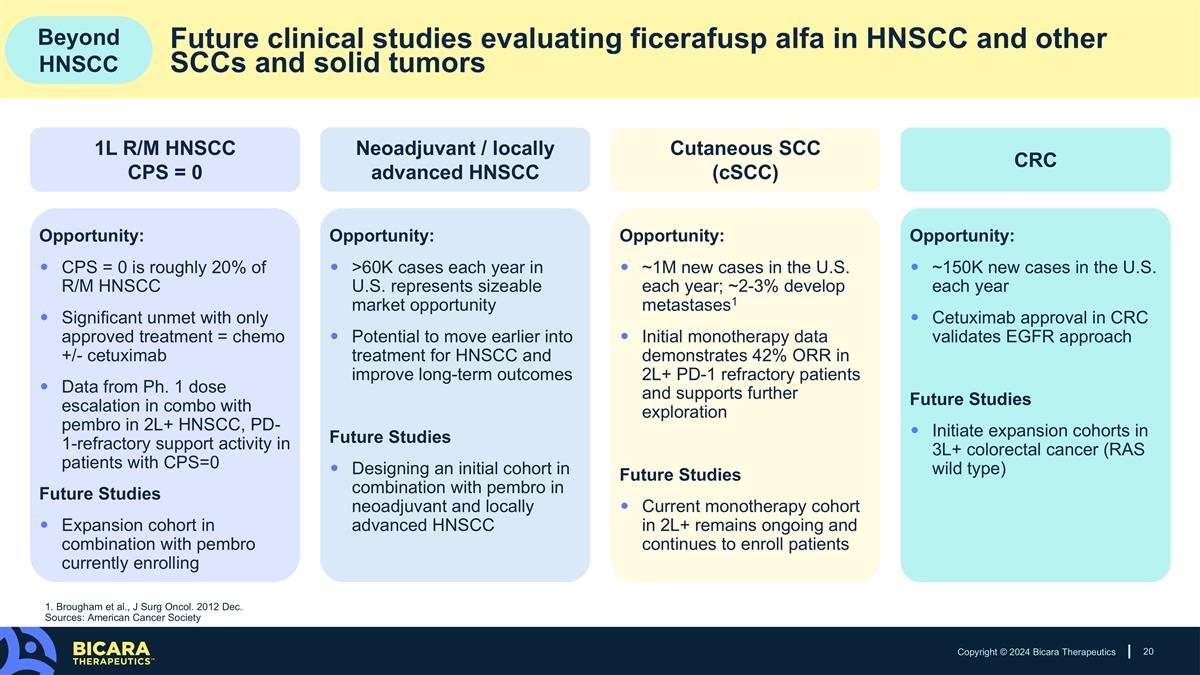
CRC Cutaneous SCC (cSCC) 1L R/M HNSCC CPS = 0 Neoadjuvant / locally advanced HNSCC Copyright © 2024 Bicara Therapeutics Future clinical studies evaluating ficerafusp alfa in HNSCC and other SCCs and solid tumors Beyond HNSCC Opportunity: CPS = 0 is roughly 20% of R/M HNSCC Significant unmet with only approved treatment = chemo +/- cetuximab Data from Ph. 1 dose escalation in combo with pembro in 2L+ HNSCC, PD-1-refractory support activity in patients with CPS=0 Future Studies Expansion cohort in combination with pembro currently enrolling Opportunity: >60K cases each year in U.S. represents sizeable market opportunity Potential to move earlier into treatment for HNSCC and improve long-term outcomes Future Studies Designing an initial cohort in combination with pembro in neoadjuvant and locally advanced HNSCC Opportunity: ~1M new cases in the U.S. each year; ~2-3% develop metastases1 Initial monotherapy data demonstrates 42% ORR in 2L+ PD-1 refractory patients and supports further exploration Future Studies Current monotherapy cohort in 2L+ remains ongoing and continues to enroll patients Opportunity: ~150K new cases in the U.S. each year Cetuximab approval in CRC validates EGFR approach Future Studies Initiate expansion cohorts in 3L+ colorectal cancer (RAS wild type) 1. Brougham et al., J Surg Oncol. 2012 Dec. Sources: American Cancer Society
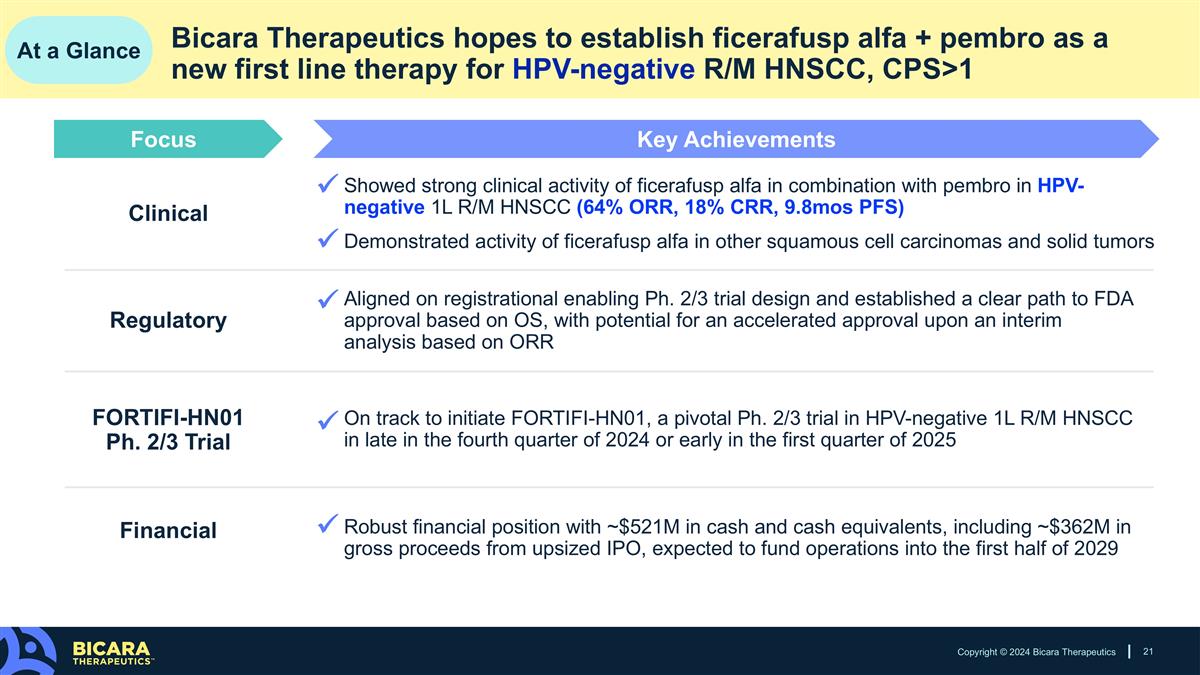
Clinical Showed strong clinical activity of ficerafusp alfa in combination with pembro in HPV-negative 1L R/M HNSCC (64% ORR, 18% CRR, 9.8mos PFS) Demonstrated activity of ficerafusp alfa in other squamous cell carcinomas and solid tumors Copyright © 2024 Bicara Therapeutics Bicara Therapeutics hopes to establish ficerafusp alfa + pembro as a new first line therapy for HPV-negative R/M HNSCC, CPS>1 Regulatory FORTIFI-HN01 Ph. 2/3 Trial Financial Aligned on registrational enabling Ph. 2/3 trial design and established a clear path to FDA approval based on OS, with potential for an accelerated approval upon an interim analysis based on ORR On track to initiate FORTIFI-HN01, a pivotal Ph. 2/3 trial in HPV-negative 1L R/M HNSCC in late in the fourth quarter of 2024 or early in the first quarter of 2025 Robust financial position with ~$521M in cash and cash equivalents, including ~$362M in gross proceeds from upsized IPO, expected to fund operations into the first half of 2029 Key Achievements Focus ü ü ü ü ü At a Glance
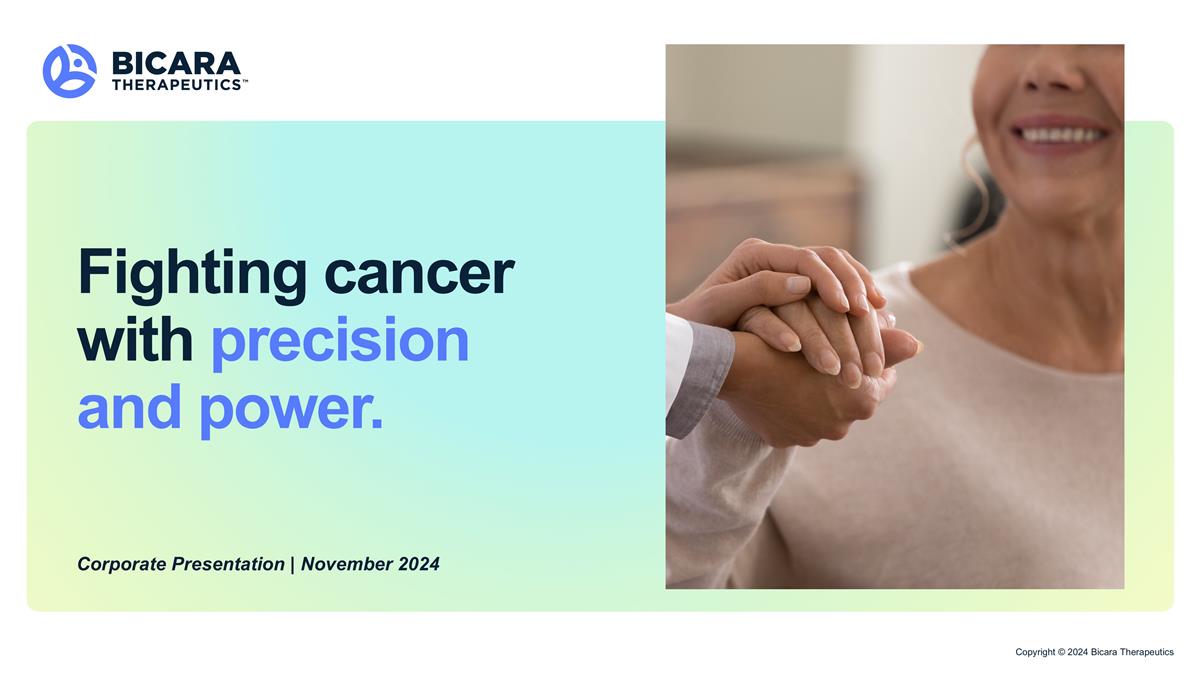
Fighting cancer with precision and power. Corporate Presentation | November 2024 Copyright © 2024 Bicara Therapeutics





















